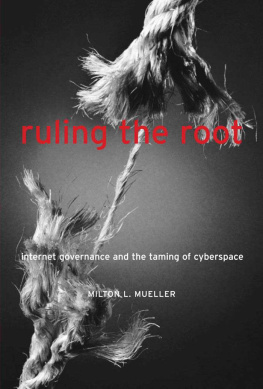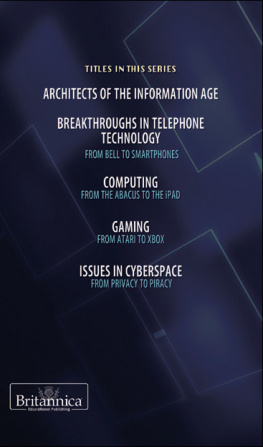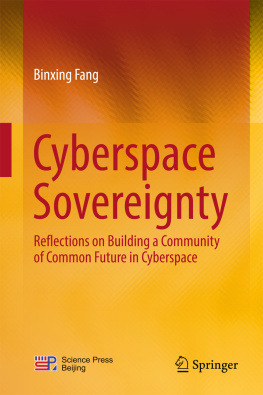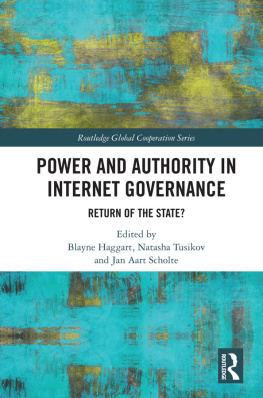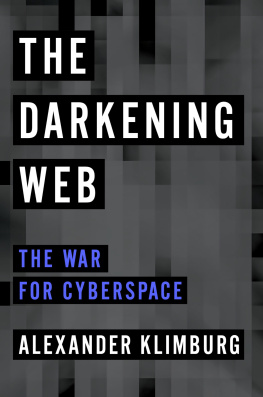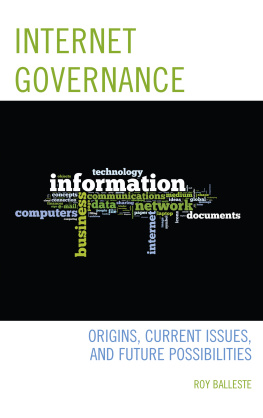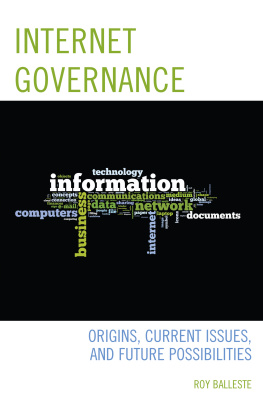Milton Mueller - Ruling the Root: Internet Governance and the Taming of Cyberspace
Here you can read online Milton Mueller - Ruling the Root: Internet Governance and the Taming of Cyberspace full text of the book (entire story) in english for free. Download pdf and epub, get meaning, cover and reviews about this ebook. year: 2002, publisher: MIT Press, genre: Computer. Description of the work, (preface) as well as reviews are available. Best literature library LitArk.com created for fans of good reading and offers a wide selection of genres:
Romance novel
Science fiction
Adventure
Detective
Science
History
Home and family
Prose
Art
Politics
Computer
Non-fiction
Religion
Business
Children
Humor
Choose a favorite category and find really read worthwhile books. Enjoy immersion in the world of imagination, feel the emotions of the characters or learn something new for yourself, make an fascinating discovery.
- Book:Ruling the Root: Internet Governance and the Taming of Cyberspace
- Author:
- Publisher:MIT Press
- Genre:
- Year:2002
- Rating:4 / 5
- Favourites:Add to favourites
- Your mark:
- 80
- 1
- 2
- 3
- 4
- 5
Ruling the Root: Internet Governance and the Taming of Cyberspace: summary, description and annotation
We offer to read an annotation, description, summary or preface (depends on what the author of the book "Ruling the Root: Internet Governance and the Taming of Cyberspace" wrote himself). If you haven't found the necessary information about the book — write in the comments, we will try to find it.
Milton Mueller: author's other books
Who wrote Ruling the Root: Internet Governance and the Taming of Cyberspace? Find out the surname, the name of the author of the book and a list of all author's works by series.
Ruling the Root: Internet Governance and the Taming of Cyberspace — read online for free the complete book (whole text) full work
Below is the text of the book, divided by pages. System saving the place of the last page read, allows you to conveniently read the book "Ruling the Root: Internet Governance and the Taming of Cyberspace" online for free, without having to search again every time where you left off. Put a bookmark, and you can go to the page where you finished reading at any time.
Font size:
Interval:
Bookmark:
Milton L. Mueller
The MIT Press
Cambridge, Massachusetts London, England
All rights reserved. No part of this book may be reproduced in any form by any electronic or mechanical means (including photocopying, recording, or information storage and retrieval) without permission in writing from the publisher.
This book was set in Sabon by Graphic Composition, Inc., Athens, GeorgiaPrinted and bound in the United States of America.Library of Congress Cataloging-in-Publication DataMueller, Milton.
Ruling the root : Internet governance and the taming of cyberspace /
Milton L. Mueller.
p. cm.
Includes bibliographical references and index.
ISBN 0-262-13412-8 (hc : alk. paper)
1. InternetGovernment policy. 2. Internet addressesGovernment
policy. 3. CyberspaceGovernment policy. 4. Telecommunication policy.
5. Right of property. 6. Institutional economics. 7. Organizational change.
I. Title.
1.1 A Constitutional Moment 3
1.2 The Root 5
1.3 Governance 7
1.4 Institutionalization 10
1.5 Goals and Plan of the Book 11
I The Root as Resource
2.1 Uniqueness Requires Coordination 15
2.2 Defining the Space 16
2.3 Assigning Unique Values 17
2.4 Governance Arrangements 26
2.5 An Example: The Ethernet Address Space 27
2.6 Review of the Framework 29
3.1 The Internet Address Space 32
3.2 The Internet Name Space 39
3.3 The DNS Root 47
3.4 Conclusion 56
4.1 Formation of Property Rights 58
4.2 Property Rights 60
4.3 Technological Change, Endowment, and Appropriation 61 4.4 Institutionalization 63
4.5 Applying the Framework to Internet Governance 67
II The Story of the Root
5.1 Prehistory 74
5.2 The Origin of the Root 75
5.3 Growth and Convergence 82
5.4 Growth and Governance 89
5.5 Who Controlled the Root? 98
6.1 Endowment: Commercial Use and the World Wide Web 106 6.2 Conflicts over Second-Level Domains 115
6.3 Conflicts over TopLevel Domains 124
6.4 Conflicts over the Root 134
7.1 IAHC and the gTLDMoU 142
7.2 Political Reaction to the gTLDMoU 146
7.3 Challenges to Network Solutions 151
7.4 The U.S. Government Intervenes 154
7.5 The Green Paper and Its Aftermath 159
8.1 From Green Paper to White Paper 164
8.2 The International Forum on the White Paper 175
9.1 Redistributing the Riches of .com: Registrar Accreditation 186 9.2 Branding the Name Space: WHOIS and UDRP 190 9.3 The Assimilation of Network Solutions 194
9.4 U.S. Government Policy Authority over the Root 197 9.5 Representation: Barriers to Entry 197
9.6 New TopLevel Domains 201
9.7 Country Codes and National Governments 205
III Issues and Themes
10.1 What ICANN Is Not 212
10.2 What ICANN Is 217
10.3 Forces Affecting ICANNs Future 221
11.1 A Web Site by Any Other Name... 228 11.2 Expanding Trademark Rights 231
11.3 New Rights in Names: WIPO 2 238
11.4 Free Expression vs. Controlled Vocabulary 245 11.5 DNS vs. WIPO 252
12.1 Artificial Scarcity: Positive Feedback and Path
Selected Acronyms 269
For two days in July 1998, one hundred and fifty people gathered in a windowless hotel convention room in Reston, Virginia. The crowd comprised techies in T-shirts, trademark lawyers in suits, academic and business people, and a small but significant number of Europeans, Latin Americans, and Asians. The meeting had an ambitious goal: to prepare a model, a set of common principles, a structure and general charter provisions for the formation of a global governance body for an Internet naming and addressing authority.1 The meeting was compared to an Internet constitutional convention by some. But the delegates to this convention were not diplomats or legislators, and its participants held no formal credentials. There had been some attempts to encourage preregistration, but for all practical purposes attendance was completely openanyone who walked in could participate. A call had been issued by a self-appointed, hastily assembled, and loosely defined steering committee, whose membership remained fluid and controversial for weeks afterwards. Aside from a few basic agenda and scheduling decisions, the process was made up on the spot. There were no formal committee chairs; facilitators either volunteered or were appointed. There were not even arrangements for breakout rooms for subgroups to work in, so the committees had to huddle in corners of the same noisy room and sometimes shout to make themselves heard.
The Reston meeting was the first in what turned out to be a series of four such conferences known as the International Forum on the White Paper (IFWP). Reston, Virginia, was an appropriate location for the inaugural meeting; it was ground zero of the commercial Internet explosion of the mid-1990s. The region was home to Network Solutions, Inc. (NSI), the government contractor that had turned domain name registration into a multimillion dollar business and that was the site of the critical A root server, the central source of data for coordinating the worlds Internet names. Reston itself was the headquarters of the Internet Society. The Pentagon and the National Science Foundation, whose sponsorship of the Internet had pushed it to the brink of global critical mass, were only a few miles away. So was the Corporation for National Research Initiatives (CNRI), which hosted the secretariat of the Internet Engineering Task Force (IETF) and once served as the organizational home of Robert Kahn and Vint Cerf, the joint inventors of the Internet protocol. Commercial firms that had risen to prominence with the Internet, such as MCI, PSINet and America Online, located their headquarters nearby.
For several years it had been clear that the Internet was no longer a subsidized tool of education and research but a vibrant new global medium. The Internet was growing at exponential rates, and its importance to the economy was becoming increasingly evident. But key technical functions such as name and address management were still performed under contracts with the U.S. military and the National Science Foundation. Foreign governments were becoming increasingly restive about unilateral U.S. control of such an important part of the global communication infrastructure. Network Solutions unplanned-for and increasingly lucrative monopoly over domain name registration was also a point of growing contention.
The transition process, everyone knew, would be risky and controversial. Domain names and IP (Internet Protocol) addresses stood at the core of the Internets operation. If they were handled poorly, the Internet could break. As the stakes grew higher, however, the Internet community had fallen into rancorous battles over policy and control. The years of escalating tension became known as the domain name wars. Finally, in July 1997, the U.S. Department of Commerce initiated a formal proceeding to privatize the domain name system (NTIA 1997). The result was a policy document officially titled Management of Internet Names and Addresses but universally known in Internet circles as simply the White Paper (NTIA 1998b).
With the release of the White Paper on June 3, 1998, the U.S. government took an unusual approach to the transition. Instead of using its rulemaking powers to settle issues, instead of creating an organization and specifying the rules it would follow, it threw the responsibility back to the warring parties, back to what it called private sector stakeholders. The governments announced intention was to recognize... and seek international support for a new, not-for-profit corporation formed by private sector Internet stakeholders (NTIA 1998b, 31749). That new corporation, not the U.S. government, would make the difficult policy decisions. It was up to the Internet community itself to form this organization and come to the U.S. government with a single proposal that commanded the unified support of the global Internet community. This had to be done in only four months.
Font size:
Interval:
Bookmark:
Similar books «Ruling the Root: Internet Governance and the Taming of Cyberspace»
Look at similar books to Ruling the Root: Internet Governance and the Taming of Cyberspace. We have selected literature similar in name and meaning in the hope of providing readers with more options to find new, interesting, not yet read works.
Discussion, reviews of the book Ruling the Root: Internet Governance and the Taming of Cyberspace and just readers' own opinions. Leave your comments, write what you think about the work, its meaning or the main characters. Specify what exactly you liked and what you didn't like, and why you think so.

